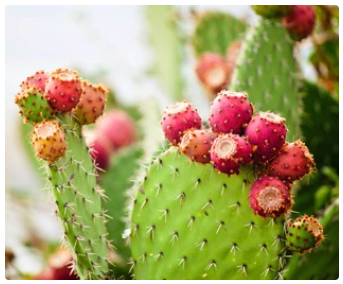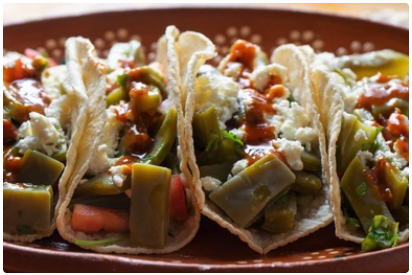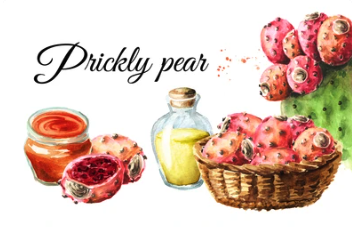
The Prickly Pear cactus (Opuntia spp) or Nopal is a traditional ingredient in Mexican cooking, dating back to pre-Colombian times. The word “nopal” comes from the Nahuatl word “nopalli” referring to the pads of the plant.
As its name suggests, the prickly pear is characterized by its unique physical appearance with flat fleshy oval to round pads called cladodes which give the plant an appearance of stacked, leaf-like sections. These pads are usually green and fleshy and can grow up to 16 inches long, covered with clusters of small sharp spines (glochids). Being a typical desert plant, it grows well in the hot arid climate and can survive long periods of drought. This plant flowers in the early spring and summer and after flowering produces fruits known as tunas – also covered with a prickly exterior but very sweet and edible.

Native to the Americas it has long been a source of nourishment and healing and recent studies have revealed a wealth of health benefits that is making this variety of cactus even more popular. It’s no wonder that this nutritional food can be found not only in Mexican homes but in many southwest restaurants and as an ingredient in many unique and commercially produced food products. It’s even featured on the Mexican flag, where you can find an eagle perched on a nopal, devouring a serpent!
Health Benefits of the Nopal
Rich Nutrient Profile: It’s a powerhouse of essential nutrients, rich in dietary fiber, vitamins C and E and minerals such as calcium, magnesium, and potassium. It is a great weight management low-calorie choice with a high water content.
Excellent for Digestive Health: The high dietary fiber in this cactus aids digestion by adding bulk to the diet and promoting a healthy gut microbiome. It helps prevent constipation, bloating and more serious digestive ailments.
Regulates Blood Sugar Levels: Its potential to regulate blood sugar levels is one of the most researched health benefits of prickly pear cactus. Studies have shown that consuming the plant can lower blood glucose levels which helps to manage type 2 diabetes. Its high fiber content slows down the absorption of sugar in the body, reducing glucose spikes after eating.
Boosts Immunity and Skin Health: Packed with antioxidants, in particular vitamin C and polyphenols, this cactus can help boost the immune system and protect the body against harmful free radicals. Such antioxidants are vital to good skin health and help with premature aging reducing inflammation and promoting the healing of wounds.
Supports Heart Health: Being rich in potassium, the prickly pear cactus is known to regulate blood pressure and support good heart health. The presence of fiber and pectin aids in lowering levels of bad LDL cholesterol reducing the risk of heart disease.
Anti-Inflammatory: The prickly pear cactus has potent anti-inflammatory properties. Its extract has been found to reduce inflammation in muscle damage and gastrointestinal disorders.
Harvesting Nopales & Tunas
The harvesting process of nopales is labor-intensive and requires skilled hands to avoid the tiny, sharp spines found on the pads. The younger pads have fewer spines and so are the preferred choice for culinary use. They are harvested early in the morning to reduce water loss using a long-handled sharp tool so that the pads can be cut, and the spines avoided. Once cut, these spines are removed manually or, in larger operations, mechanically.
The prickly pear is a common ingredient in salads, soups, and other types of Mexican cuisine. Recently featured in an article entitled “Prickly Pear Cactus Tacos”, they were described as having the taste of a “slightly tangy green bean”. The Nopal is referred to as the Mexican Superfood and can be cooked in a variety of ways – boiled, grilled, eaten raw or juiced, and added to stews, salsas, smoothies, and eggs. In the cosmetic world the nopal is valued for its potential health benefits and used in creams, lotions, and shampoos.
The harvesting of the fruit or “tuna” as It is called is also a bit tricky. It is usually done by hand using a long, hooked pole to twist the fruit off the plant and then de-spined. Prickly pear fruits are sold fresh, but often found in products like jams, jellies, and juices. They have a sweet, melon-like flavor and are high in fiber, vitamin C and antioxidants. The prickly pear seed oil from inside the fruit is highly valued in the cosmetics industry being rich in linoleic acid and vitamin E.

This highly versatile plant has significant commercial value in food products, cosmetics and the health industry. As its popularity increases, the harvesting and de-spining methods with improve to offset the high level of manual labor required.
Ready to try some Nopales? You won’t be disappointed – they’re delicious!
By Lily Noon
Sources:
- The Remarkable Power of the Prickly Pear, Future Planet, BBC, by Miguel Tramcozo Trevino, May 25, 2020
- Prickly Pear Cactus Tacos, World Table BBC, by Nicole Melancon, July 22, 2023
- Antioxidant Betalains from Cactus Pear (Opuntia ssp.) Inhibit Endothelial lCAM-1 Expression” (Gentile C, Tesoriere L, Allegra M, et al;, Annals of the New York Academy of Sciences 2004)
- “Hypoglycemic Influence of Opuntia streptacantha Lemaire in Patients with Type 2 Diabetes” (Frati-Munari AC, Gordillo BE, Altamirano P, Ariza CR, Diabetes Care, 1988
- “Prickly pear (Opuntia spp.) as a source of bioactive compounds for nutrition, health and disease”, (El-Mostafa K, El Kharrassi Y, Badreddne A, et al., Molecules 2014.)
ウチワサボテン(オプンティア)は、メキシコの伝統的な食材で、コロンブス到着前に遡る歴史があります。メキシコでは「nopal」と呼ばれていますが、これは先住民族のナワトル語でこのサボテンが「nopalli」と呼ばれていることに由来します。
英語では「prickly pear cactus」ですが、「prickly pear」は刺だらけのナシ、「cactus」はサボテンという意味で、まさにその独特の見た目のとおりです。サボテンの茎の部分は平たい楕円形または円形で、肉厚の葉が連なっているように見えます。この茎部分は通常は緑色で分厚く、1つの楕円が最大40センチぐらいに成長し、クラスター状に生える小さな刺に覆われています。典型的な砂漠の植物で、暑く乾燥した天候で繁茂し、長期の干ばつにも耐えることができます。花が咲くのは早春と夏で、花の後に実がなり、この実がメキシコでは「tuna」と呼ばれています。実も外側は刺だらけですが、とても甘い食用果実です。
ウチワサボテンはアメリカ大陸原産の植物で、古くから食用および薬用に使われてきましたが、最近の研究で多大な健康メリットがあることが分かり、このサボテンの人気をますます高めています。この栄養豊富な食べ物が、今やメキシコの家庭だけでなく、米国南西部の多数のレストランでも食されているのは驚きではありません。さらに、商業生産されるユニークな食品の多くでも原材料に使われています。ウチワサボテンは、メキシコの国旗にも描かれています。実を付けたウチワサボテンに立つワシが、ヘビをくわえているではありませんか!
ウチワサボテンの健康メリット
栄養満点:ウチワサボテンは栄養満点です。食物繊維、ビタミンC、ビタミンE、さらにはカルシウム、マグネシウム、カリウムなどのミネラルが豊富に含まれています。しかも水分量が多く低カロリーですから、ダイエット食にも適しています。
消化促進:食物繊維は食事のボリューム感を増し、胃腸のマイクロバイオームを整えることで、消化を促進します。便秘や腹部膨満感、さらにはもっと深刻な消化器系疾患の予防に役立ちます。
血糖値を正常化:ウチワサボテンの健康メリットとして最もよく研究されている点のひとつが、血糖値を正常化する可能性です。これを食べると血糖値が下がり、結果として2型糖尿病の管理に役立つことが証明されてきました。食物繊維が豊富なため糖分の吸収が鈍化し、食後の血糖値の上昇を抑えます。
免疫力と皮膚の健康を向上:抗酸化物質がいっぱいで、特にビタミンCとポリフェノールを豊富に含んでいることから、免疫力の向上と有害なフリーラジカルからの保護が期待できます。これらの抗酸化物質は、皮膚の健康にも欠かせません。アンチエイジング効果をもたらし、炎症を抑えて、傷口の治癒も促します。
心臓をサポート:カリウムが豊富なウチワサボテンは、血圧を正常化し、心臓の健康をサポートすることでも知られています。食物繊維とペクチンが悪玉コレステロールの降下に寄与して、心臓病のリスクを引き下げます。
抗炎症効果:ウチワサボテンには、強力な抗炎症効果もあります。エキスが筋肉損傷の炎症を抑え、胃腸疾患にも効くことが分かっています。
ウチワサボテンの茎と果実の収穫
ウチワサボテンの収穫作業は、大変手間がかかります。茎にある鋭利で微細な刺を避けるには、かなりのスキルが求められます。若い茎は刺が少なく、このため食用としても好まれます。水分の喪失を抑えるため収穫は朝早くに行われ、長い取っ手の付いた鋭いナイフで茎を切り取ることで、刺に触れないようにします。切り取った後、手作業で刺を抜くか、大規模な農場では機械で除去することもあります。
ウチワサボテンは、スープやサラダ、その他のメキシコ料理によく使われます。最近、「ウチワサボテン・タコス」と題したレシピの記事を見かけましたが、「わずかにクセのあるサヤインゲン」の味がすると説明されていました。ウチワサボテンの茎はメキシコのスーパーフードと言われていて、茹でる、焼くなどさまざまな方法で調理できます。生食やジュースにもでき、シチュー、サルサ、スムージー、卵料理に加えて楽しめます。健康メリットの可能性があるため化粧品の世界でも重用されていて、クリーム、ローション、シャンプーなどに使われています。
ウチワサボテンの果実の収穫も、やはりコツを要します。通常は手作業で、先端の曲がった長い棒を使って茎からもぎ取り、それから刺を抜きます。果実は生鮮で販売されますが、ジャムやゼリー、ジュースなどの製品でもよく見かけます。甘いメロンに似た風味で、食物繊維とビタミンCと抗酸化物質が豊富です。果実の種から採取するオイルは、リノール酸とビタミンEが豊富なため、化粧品業界できわめて高い価値を置かれています。
この多目的な植物は、食品として、化粧品として、また健康業界にとっても、高い商業価値を持っています。人気が高まるにつれ、収穫と刺抜きの方法も改善して、手作業のニーズが下がっていくでしょう。
皆さんもウチワサボテンを試してみませんか? 決してがっかりしないはずです。美味しいですよ!
By Lily Noon
出典:
- The Remarkable Power of the Prickly Pear(ウチワサボテンの驚くべきパワー)、BBC、著:Miguel Tramcozo Trevino、2020年5月25日
- Prickly Pear Cactus Tacos(ウチワサボテン・タコス)、BBC、著:Nicole Melancon、2023年7月22日
- Antioxidant Betalains from Cactus Pear (Opuntia ssp.) Inhibit Endothelial lCAM-1 Expression(ウチワサボテン(オプンティア)の抗酸化物質ベタレインが血管内皮lCAM-1の発現を抑制)著:Gentile C、Tesoriere L、Allegra Mほか、Annals of the New York Academy of Sciences、2004年
- Hypoglycemic Influence of Opuntia streptacantha Lemaire in Patients with Type 2 Diabetes(2型糖尿病患者におけるオプンティアの低血糖影響)、著:Frati-Munari AC、Gordillo BE、Altamirano P、Ariza CR、Diabetes Care、1988年
- Prickly pear (Opuntia spp.) as a source of bioactive compounds for nutrition, health and disease(栄養・健康・疾病のための生体活性化合物源としてのウチワサボテン(オプンティア))、著:El-Mostafa K、El Kharrassi Y、Badreddne Aほか、Molecules、2014年
